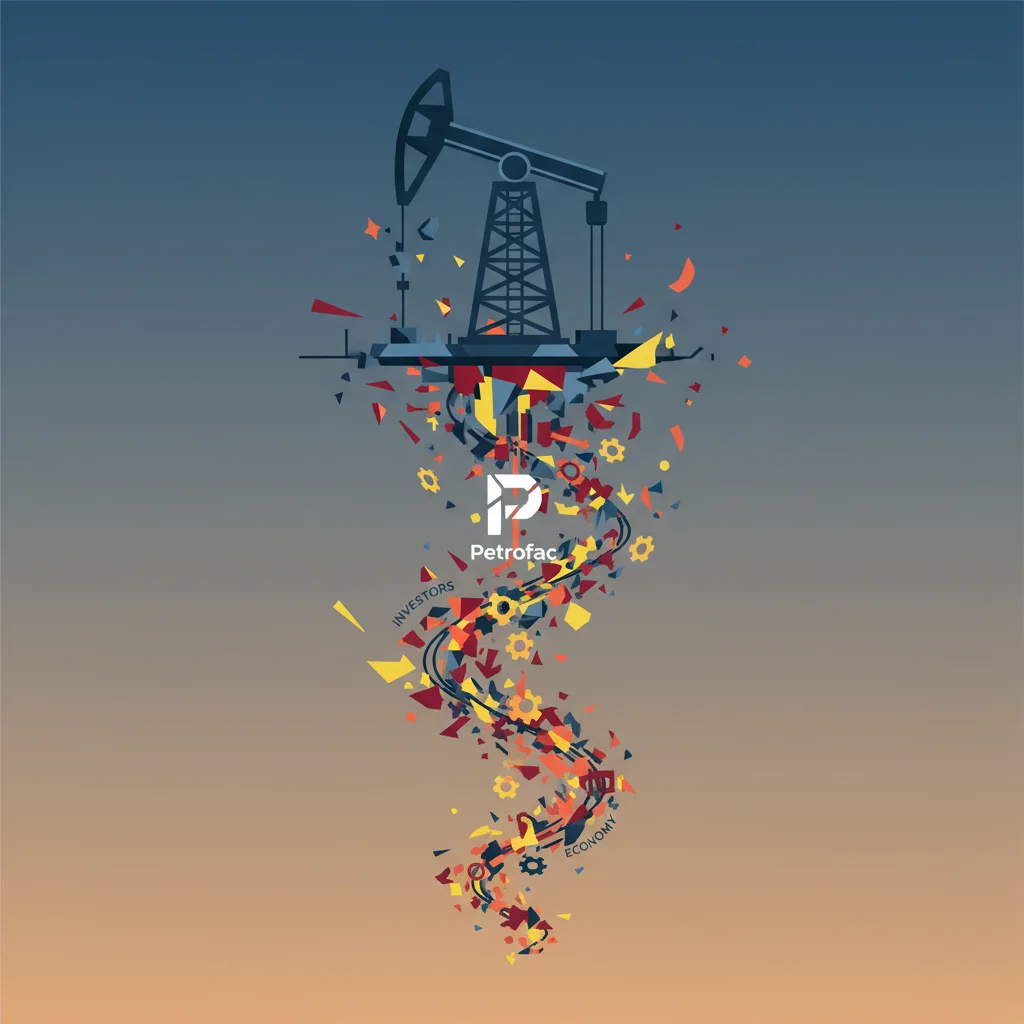
Anatomy of a Downfall: Petrofac’s Collapse and the Hard Lessons for Investors and the Economy
A Titan Stumbles: The Shocking Fall of Petrofac
In the high-stakes world of global energy, few names carried as much weight as Petrofac. A titan of engineering and construction for the oil and gas industry, the company was a cornerstone of the UK’s energy sector and a significant employer, particularly in Scotland. However, the foundations of this giant have crumbled. In a move that sent shockwaves through the financial markets, Petrofac announced that several of its key subsidiaries would be filing for administration as part of a desperate, last-ditch financial restructuring. This isn’t just another corporate headline; it’s a complex saga of debt, scandal, and strategic missteps with profound implications for the economy, the stock market, and anyone involved in corporate finance.
The company, which employs approximately 2,000 people in Scotland alone, has been navigating turbulent waters for years. Its fall from grace serves as a powerful case study for investors, business leaders, and finance professionals on how quickly a corporate powerhouse can be brought to its knees. To truly understand the gravity of this situation, we must look beyond the surface-level news and dissect the chain of events that led to this precipice, exploring the intricate financial maneuvers designed to save it and the painful consequences for its stakeholders.
The Long Shadow of Scandal and Debt
A company’s collapse is rarely a sudden event. For Petrofac, the seeds of its current crisis were sown years ago, primarily stemming from a bribery scandal that irrevocably tarnished its reputation and crippled its finances. In 2021, the company was ordered to pay a staggering £77 million ($94 million) after an investigation by the UK’s Serious Fraud Office (SFO) found it had paid bribes to secure contracts in the Middle East. According to the SFO, the corruption spanned over several years, from 2011 to 2017 (source).
This wasn’t just a financial penalty; it was a scarlet letter. The conviction made it exceedingly difficult for Petrofac to secure new contracts, particularly from state-owned oil companies that have stringent anti-corruption clauses. The lifeblood of an engineering services firm is a healthy pipeline of new projects. With its reputation in tatters, Petrofac’s pipeline began to dry up, leading to a cascade of financial problems. Revenue faltered, but its massive debt obligations remained, creating a classic liquidity crisis.
To illustrate the steady decline, let’s examine a timeline of the key events that sealed Petrofac’s fate.
| Date / Period | Key Event | Impact on the Company |
|---|---|---|
| 2017-2021 | Serious Fraud Office (SFO) Investigation | Created significant market uncertainty, increased legal costs, and made it difficult to secure project financing and performance guarantees. |
| October 2021 | Conviction and £77m Fine | Crystallized reputational damage, leading to debarment from bidding on contracts in key markets like the UAE for a period. |
| 2022-2023 | Mounting Debt & Liquidity Squeeze | The company struggled to refinance its debt as lenders became wary. Its credit rating was downgraded, making borrowing more expensive. |
| April 2024 | Failed Equity Raise | An attempt to raise capital from the market failed, signaling a complete loss of investor confidence and triggering a share price collapse. |
| May/June 2024 | Restructuring Plan & Administration Filing | The company announces a comprehensive debt-for-equity swap and places subsidiaries into administration to implement the plan, effectively wiping out existing shareholders. |
A Stark Admission: UK Chancellor Declares Brexit Deal Caused "Long-Term Economic Damage"
Dissecting the “Debt-for-Equity” Lifeline
With traditional financing routes closed and the stock market turning its back, Petrofac was forced into a complex financial restructuring. The centerpiece of this plan is a “debt-for-equity swap,” a common tool in the world of corporate finance used to save companies teetering on the brink of collapse.
In simple terms, a debt-for-equity swap involves the company’s lenders (creditors) agreeing to cancel a portion of the debt owed to them. In exchange, they receive ownership (equity) in the restructured company. For Petrofac, this means that senior secured noteholders will forgive $300 million in debt in return for a controlling stake in the new, hopefully viable, entity. While this provides a critical lifeline by reducing the debt burden and injecting new liquidity, it comes at a brutal cost to existing shareholders.
The plan explicitly states that existing shareholders will see their holdings diluted to virtually zero. Their shares, once representing ownership in a multi-billion dollar enterprise, will become essentially worthless. This is a stark reminder for anyone involved in investing: when a company enters this level of distress, shareholders are last in line to be paid, behind lenders, bondholders, and other creditors.
The Ripple Effect: Beyond the Balance Sheet
The fallout from Petrofac’s administration extends far beyond its shareholders and creditors. The situation has significant implications for the broader economy, particularly in the UK.
Impact on the UK Energy Sector
Petrofac is a critical part of the North Sea oil and gas supply chain. Its expertise in managing, maintaining, and decommissioning offshore assets is vital. While the restructuring aims to ensure operational continuity, any disruption could have a knock-on effect on other companies and projects in the region. It highlights the fragility of the ecosystem that supports the UK’s energy infrastructure, a system already under pressure from the global transition towards cleaner energy.
A Cautionary Tale for the Stock Market
The delisting of Petrofac’s shares from the London Stock Exchange serves as a chilling lesson in investment risk. Retail and institutional investors who held on, hoping for a recovery, have been completely wiped out. This event underscores the importance of scrutinizing a company’s debt levels, corporate governance, and legal challenges, not just its revenue forecasts. For those involved in trading, it demonstrates how quickly sentiment can turn and how fundamental weaknesses can ultimately override technical market indicators.
The Role of Banking and Financial Technology
This restructuring is a major test for the banking institutions and credit providers involved. They are navigating a complex process to salvage value from a failing enterprise, balancing their own financial exposure with the need to keep a strategic industrial company alive. This is where the world of finance becomes part art, part science.
Looking forward, one might wonder how emerging financial technology could influence such scenarios. Could fintech platforms that specialize in distressed debt trading make the process of transferring ownership more efficient? Could blockchain technology offer a more transparent way to manage complex supply chain financing for large-scale engineering projects, potentially preventing the kind of payment disputes and opaque dealings that can lead to financial distress? While not a solution for Petrofac today, these are the questions the financial industry must grapple with to build more resilient systems for tomorrow’s economics.
Jamie Dimon's Economic Forecast: Navigating the Storm Clouds of Global Finance
Conclusion: Lessons from the Rubble
Petrofac’s journey into administration is a multifaceted story. It is a story of a company that reached the pinnacle of its industry but failed to safeguard its ethical and financial foundations. The bribery scandal was the initial, powerful earthquake, but the subsequent financial tremors of high debt and lost confidence are what ultimately brought the structure down. The restructuring plan is not a victory, but a salvage operation—an attempt to build something new and sustainable from the rubble.
For the wider world of investing and finance, the lessons are invaluable. It is a powerful reminder that a company’s culture and governance are as critical as its balance sheet. It demonstrates the brutal hierarchy of capital structure in a crisis, where shareholders’ dreams can evaporate overnight. And finally, it shows that in a globally interconnected economy, reputation is a currency that, once devalued, can trigger a financial collapse that no amount of engineering prowess can prevent.
Gove's High-Stakes Gamble: Can a 1.5 Million Home Target Reshape the UK Economy?


